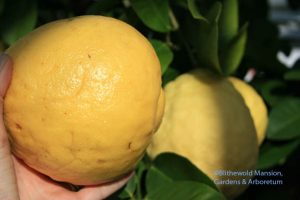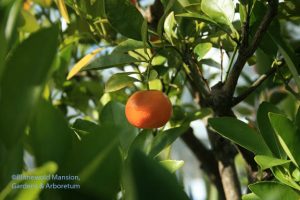House planets
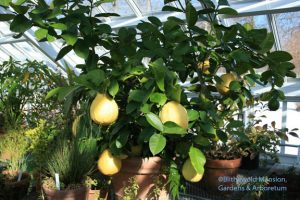
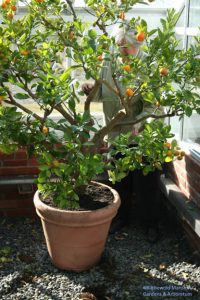 I think it’s safe to say that everyone who has ever set foot in the greenhouse makes an immediate beeline for the citrus plants. The Citrus limon ‘Ponderosa’ (a.k.a. American Wonder Lemon) definitely has its own gravitational pull. The lemons are about the size of Jupiter and hang on the plant, bowing the branches, seemingly indefinitely. Kids (of all ages) also swarm the Calamondin orange (x Citrofortunella or Citrus mitis) because it’s almost always adorned with zillions of oranges that are as comparatively tiny as the Ponderosa lemons are enormous. The Ponderosa lemon began as a chance seedling grown by George Bowman of Maryland in the late 1880’s and has been commercially available since the turn of the 20th century. — I suspect that the legendary Logee’s Greenhouse specimen is at least that old. The Calamondin is a Southeast Asian hybrid and our own tree is over 40 years old.
I think it’s safe to say that everyone who has ever set foot in the greenhouse makes an immediate beeline for the citrus plants. The Citrus limon ‘Ponderosa’ (a.k.a. American Wonder Lemon) definitely has its own gravitational pull. The lemons are about the size of Jupiter and hang on the plant, bowing the branches, seemingly indefinitely. Kids (of all ages) also swarm the Calamondin orange (x Citrofortunella or Citrus mitis) because it’s almost always adorned with zillions of oranges that are as comparatively tiny as the Ponderosa lemons are enormous. The Ponderosa lemon began as a chance seedling grown by George Bowman of Maryland in the late 1880’s and has been commercially available since the turn of the 20th century. — I suspect that the legendary Logee’s Greenhouse specimen is at least that old. The Calamondin is a Southeast Asian hybrid and our own tree is over 40 years old.
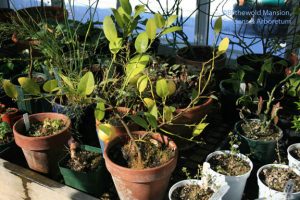 Citruses are not the easiest houseplants – and given the plight of California citrus trees which are being threatened by a bacteria that causes a “greening disease“, and Florida citruses which periodically succumb to drops in temperature, they might not be the easiest garden plants either. Logee’s recommends temperatures above 60° in the winter (although many can take it as cold as 40°), to water when the soil appears dry and fertilize sparingly. My Citrus aurantifolia ‘Key Lime’ evidently can’t tolerate temperatures below 60° throughout the winter which would explain why it looks as stressed out as it does – even our warmest greenhouse, where it is currently recouping from pure torture at my house, is chillier than that at night. It, like the rest of our citrus plants, is also plagued by scale (a tiny sucking insect protected by a tough brown shell) which produces a sticky honeydew poop that is a terrific host for sooty mold. We treat the plants by washing the leaves, stems and branches by hand with insecticidal or dilute dish soap. We must be doing something right this winter because we haven’t washed the lemon in ages and (knock wood) it’s never looked so healthy. Occasionally the leaves on our citruses turn yellow which indicates an iron deficiency and possibly that they’ve been over watered. Both are problems are treatable.
Citruses are not the easiest houseplants – and given the plight of California citrus trees which are being threatened by a bacteria that causes a “greening disease“, and Florida citruses which periodically succumb to drops in temperature, they might not be the easiest garden plants either. Logee’s recommends temperatures above 60° in the winter (although many can take it as cold as 40°), to water when the soil appears dry and fertilize sparingly. My Citrus aurantifolia ‘Key Lime’ evidently can’t tolerate temperatures below 60° throughout the winter which would explain why it looks as stressed out as it does – even our warmest greenhouse, where it is currently recouping from pure torture at my house, is chillier than that at night. It, like the rest of our citrus plants, is also plagued by scale (a tiny sucking insect protected by a tough brown shell) which produces a sticky honeydew poop that is a terrific host for sooty mold. We treat the plants by washing the leaves, stems and branches by hand with insecticidal or dilute dish soap. We must be doing something right this winter because we haven’t washed the lemon in ages and (knock wood) it’s never looked so healthy. Occasionally the leaves on our citruses turn yellow which indicates an iron deficiency and possibly that they’ve been over watered. Both are problems are treatable.
Do you have any citrus? Are they a challenge for you as well?

